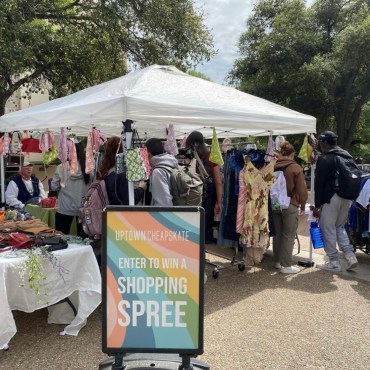Listeners:
Top listeners:
-
play_arrow
KTSW 89.9

By Claire Hansen
Blog Content Contributor
Most of you reading this probably already know what I am going to say, but I am going to say it again, simply because I believe it is important and has been made clear to me over the last couple weeks that not enough people are listening. I’d be pretty surprised if you had not seen this around campus already, but, in case you did not know, glittering. is. bad. By glittering, I mean using glitter or confetti as a cute prop in graduation photos, and then failing to clean it up afterwards, much like regular littering, which we have been taught throughout our lives never to do. So, why do people still do it? Graduation is definitely exciting, but we have to think of the greater good when committing these acts.
I will give you a quick rundown. Students who are getting ready to graduate dress up in their cap and gown to take cute pictures on campus, a lot of which are accessorized by the act of tossing confetti or glitter into the air. I can not disagree that it does make for priceless photos, but the beautiful environment we are so lucky to live in is suffering from this seasonal trend. Every time it rains (which, let’s face it, it rains a lot here), the confetti and glitter left on the open ground gets washed into the storm drains by the downpours and carried into the rivers, where our special friends like the San Marcos Salamander and the Texas Blind Salamander reside. These innocent aquatic animals often mistake our shiny plastic for food, leading to the sad and unfortunate death of many of our river’s citizens, whose species already happen to be endangered or threatened.
What is striking to me is that, despite the numerous signs found around campus instructing students in large, clear messages not to do this, and even including a diagram demonstrating what happens when the act is committed. Graduates and photographers still blatantly ignore these signs and not only go on to break these rules, but do so directly in front of the signs themselves. If that’s not a serious sign of disrespect to Texas State, our fellow students who took the time to make that sign and, most importantly, the native marine life suffering from this irresponsible deed, then I do not know what is. I am disappointed to know that some people on our beautiful campus could be this ignorant. I know I am sounding a little harsh, but come on, don’t we all adore San Marcos and the unique features that make it special to us? If we have been at Texas State long enough to earn a degree, shouldn’t we care to preserve the beauty of our little township so that others can share the same experience? Is not that what being a Bobcat is all about?

I am not here to reprimand anyone individually for the choices they have made upon getting ready to graduate. Each and every one of us with a cap and gown this semester has worked very hard to get there, and I understand that it is very worthy of a celebration. All I am saying is, let’s be more mindful of the wonderful aspects of this town that helped us reach this exciting point in our lives and made our experience so unique. There is no reason that, just because we are almost out of here, we should start the disrespect now.
There are several alternatives to this trend, and I will list a few of them: biodegradable confetti exists and can be found on multiple websites, including this one. Natural confetti-like substitutes, such as flower petals, dyed rice and birdseed also exist! You could consider placing a tarp underneath you for an up-close glitter photo, or, you could even consult someone to Photoshop glitter into your picture for you. There are options, folks, and it’s time we put that degree to use and be conscious in our efforts to preserve our beautiful San Marcos River.
Featured image via Texas State University.
Share this:
- Click to share on Twitter (Opens in new window)
- Click to share on Facebook (Opens in new window)
- Click to share on Tumblr (Opens in new window)
- Click to share on Pinterest (Opens in new window)
- Click to share on Reddit (Opens in new window)
- Click to email a link to a friend (Opens in new window)
- Click to print (Opens in new window)
#LitterFreeTXST Campus Littering Claire Hansen endangered species Glitter Grad Portraits KTSW 89.9 Renee Dominguez san marcos river San Marcos TX Texas State University
Similar posts
This Blog is Propery of KTSW



Post comments (0)